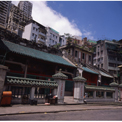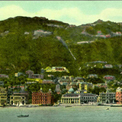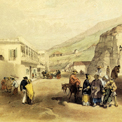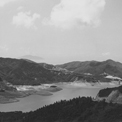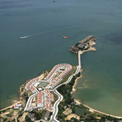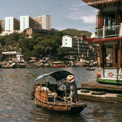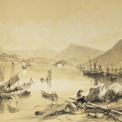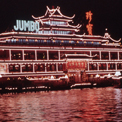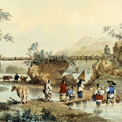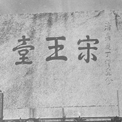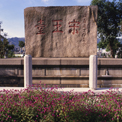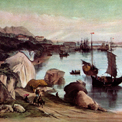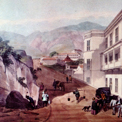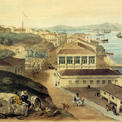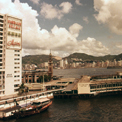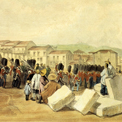Tiger Balm Garden, Tai Hang
Tiger Balm Garden, also called Haw Par Garden, was built in 1935 by the late philanthropist, Mr. Aw Boon Haw. This multi-millionaire made his name through manufacturing the "Tiger Balm" ointment, which is reputed for its miraculous healing properties and popularity among the local people. Tiger Balm Garden covers a vast area stretching up a steep hill. It is known for its beautiful artificial Chinese landscaping decorations. Its salient feature of a seven-storey White Pagoda is the only Chinese pagoda on Hong Kong Island. Particularly fascinating in Tiger Balm Garden are its thematic Chinese traditional paintings, sculptures and statues admonishing people to do good and avoid evil.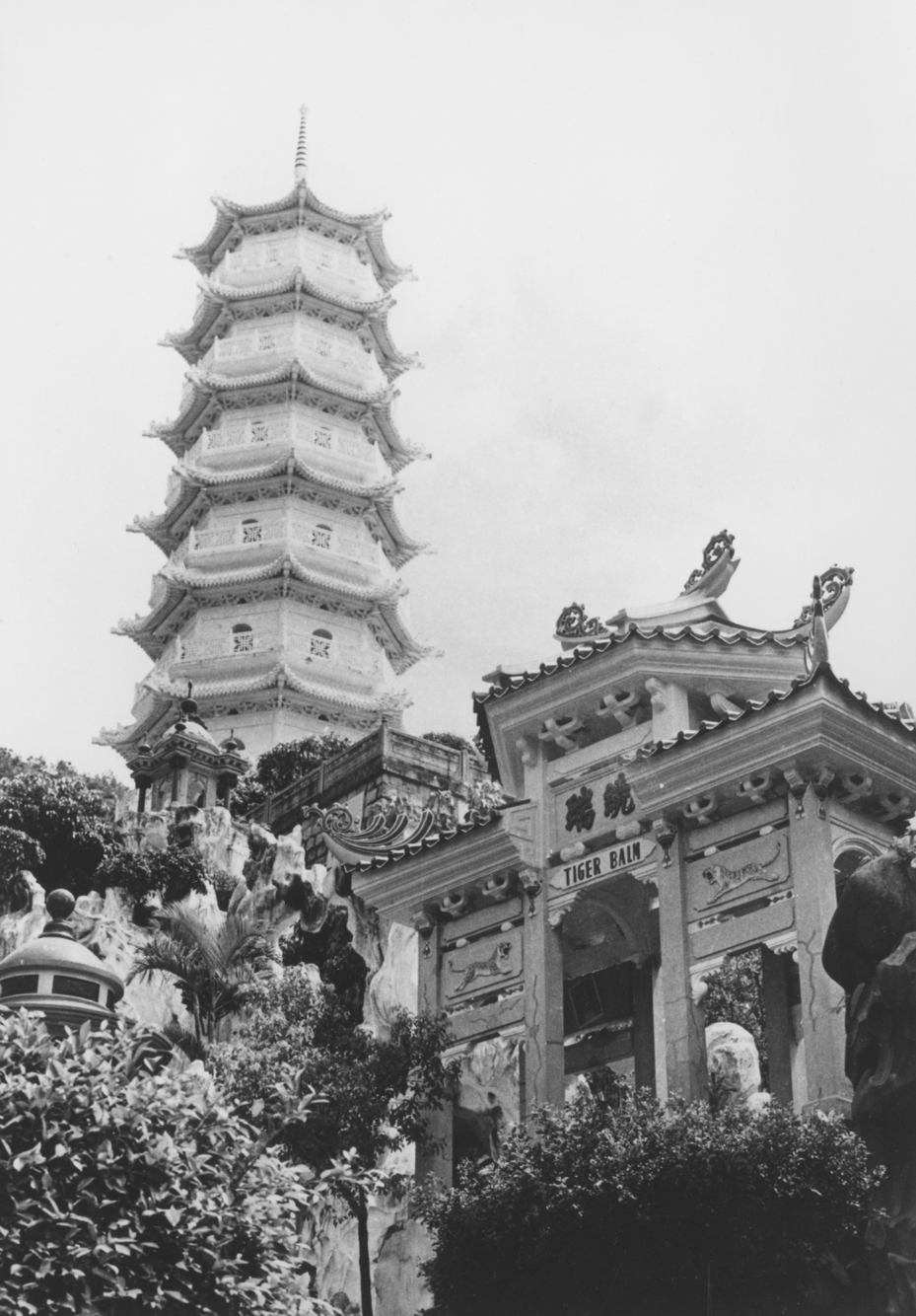
| Date | 1981 |
| Place | Hong Kong Island/Wan Chai District/Tai Hang/(Street)/Tiger Balm Garden |
| Material Type | Image |
| Collection | Hong Kong Places |
| Source | Courtesy of The University of Hong Kong Libraries |
| Repository | The University of Hong Kong Libraries |
| Accession No. | ABH_1-2 |
Tiger Balm Garden, Tai Hang
Tiger Balm Garden, also called Haw Par Garden, was built in 1935 by the late philanthropist, Mr. Aw Boon Haw. This multi-millionaire made his name through manufacturing the "Tiger Balm" ointment, which is reputed for its miraculous healing properties and popularity among the local people. Tiger Balm Garden covers a vast area stretching up a steep hill. It is known for its beautiful artificial Chinese landscaping decorations. Its salient feature of a seven-storey White Pagoda is the only Chinese pagoda on Hong Kong Island. Particularly fascinating in Tiger Balm Garden are its thematic Chinese traditional paintings, sculptures and statues admonishing people to do good and avoid evil.
| Date | 1981 |
| Place | Hong Kong Island/Wan Chai District/Tai Hang/(Street)/Tiger Balm Garden |
| Material Type | Image |
| Collection | Hong Kong Places |
| Source | Courtesy of The University of Hong Kong Libraries |
| Repository | The University of Hong Kong Libraries |
| Accession No. | ABH_1-2 |
Tiger Balm Garden, Tai Hang
Tiger Balm Garden, also called Haw Par Garden, was built in 1935 by the late philanthropist, Mr. Aw Boon Haw. This multi-millionaire made his name through manufacturing the "Tiger Balm" ointment, which is reputed for its miraculous healing properties and popularity among the local people. Tiger Balm Garden covers a vast area stretching up a steep hill. It is known for its beautiful artificial Chinese landscaping decorations. Its salient feature of a seven-storey White Pagoda is the only Chinese pagoda on Hong Kong Island. Particularly fascinating in Tiger Balm Garden are its thematic Chinese traditional paintings, sculptures and statues admonishing people to do good and avoid evil.
| Date | 1981 |
| Place | Hong Kong Island/Wan Chai District/Tai Hang/(Street)/Tiger Balm Garden |
| Material Type | Image |
| Collection | Hong Kong Places |
| Source | Courtesy of The University of Hong Kong Libraries |
| Repository | The University of Hong Kong Libraries |
| Accession No. | ABH_1-2 |
Tiger Balm Garden, Tai Hang
Tiger Balm Garden, also called Haw Par Garden, was built in 1935 by the late philanthropist, Mr. Aw Boon Haw. This multi-millionaire made his name through manufacturing the "Tiger Balm" ointment, which is reputed for its miraculous healing properties and popularity among the local people. Tiger Balm Garden covers a vast area stretching up a steep hill. It is known for its beautiful artificial Chinese landscaping decorations. Its salient feature of a seven-storey White Pagoda is the only Chinese pagoda on Hong Kong Island. Particularly fascinating in Tiger Balm Garden are its thematic Chinese traditional paintings, sculptures and statues admonishing people to do good and avoid evil.
| Date | 1981 |
| Place | Hong Kong Island/Wan Chai District/Tai Hang/(Street)/Tiger Balm Garden |
| Material Type | Image |
| Collection | Hong Kong Places |
| Source | Courtesy of The University of Hong Kong Libraries |
| Repository | The University of Hong Kong Libraries |
| Accession No. | ABH_1-2 |
Tiger Balm Garden, Tai Hang
Tiger Balm Garden, also called Haw Par Garden, was built in 1935 by the late philanthropist, Mr. Aw Boon Haw. This multi-millionaire made his name through manufacturing the "Tiger Balm" ointment, which is reputed for its miraculous healing properties and popularity among the local people. Tiger Balm Garden covers a vast area stretching up a steep hill. It is known for its beautiful artificial Chinese landscaping decorations. Its salient feature of a seven-storey White Pagoda is the only Chinese pagoda on Hong Kong Island. Particularly fascinating in Tiger Balm Garden are its thematic Chinese traditional paintings, sculptures and statues admonishing people to do good and avoid evil.
| Date | 1981 |
| Material Type | Image |
| Collection | Hong Kong Places |
| Source | Courtesy of The University of Hong Kong Libraries |
| Repository | The University of Hong Kong Libraries |
| Accession No. | ABH_1-2 |
Tiger Balm Garden, Tai Hang
Tiger Balm Garden, also called Haw Par Garden, was built in 1935 by the late philanthropist, Mr. Aw Boon Haw. This multi-millionaire made his name through manufacturing the "Tiger Balm" ointment, which is reputed for its miraculous healing properties and popularity among the local people. Tiger Balm Garden covers a vast area stretching up a steep hill. It is known for its beautiful artificial Chinese landscaping decorations. Its salient feature of a seven-storey White Pagoda is the only Chinese pagoda on Hong Kong Island. Particularly fascinating in Tiger Balm Garden are its thematic Chinese traditional paintings, sculptures and statues admonishing people to do good and avoid evil.
| Date | 1981 |
| Place | Hong Kong Island/Wan Chai District/Tai Hang/(Street)/Tiger Balm Garden |
| Material Type | Image |
| Collection | Hong Kong Places |
| Source | Courtesy of The University of Hong Kong Libraries |
| Repository | The University of Hong Kong Libraries |
| Accession No. | ABH_1-2 |
Tiger Balm Garden, Tai Hang
Tiger Balm Garden, also called Haw Par Garden, was built in 1935 by the late philanthropist, Mr. Aw Boon Haw. This multi-millionaire made his name through manufacturing the "Tiger Balm" ointment, which is reputed for its miraculous healing properties and popularity among the local people. Tiger Balm Garden covers a vast area stretching up a steep hill. It is known for its beautiful artificial Chinese landscaping decorations. Its salient feature of a seven-storey White Pagoda is the only Chinese pagoda on Hong Kong Island. Particularly fascinating in Tiger Balm Garden are its thematic Chinese traditional paintings, sculptures and statues admonishing people to do good and avoid evil.
| Date | 1981 |
| Place | Hong Kong Island/Wan Chai District/Tai Hang/(Street)/Tiger Balm Garden |
| Material Type | Image |
| Collection | Hong Kong Places |
| Source | Courtesy of The University of Hong Kong Libraries |
| Repository | The University of Hong Kong Libraries |
| Accession No. | ABH_1-2 |
Tiger Balm Garden, Tai Hang
Tiger Balm Garden, also called Haw Par Garden, was built in 1935 by the late philanthropist, Mr. Aw Boon Haw. This multi-millionaire made his name through manufacturing the "Tiger Balm" ointment, which is reputed for its miraculous healing properties and popularity among the local people. Tiger Balm Garden covers a vast area stretching up a steep hill. It is known for its beautiful artificial Chinese landscaping decorations. Its salient feature of a seven-storey White Pagoda is the only Chinese pagoda on Hong Kong Island. Particularly fascinating in Tiger Balm Garden are its thematic Chinese traditional paintings, sculptures and statues admonishing people to do good and avoid evil.
| Date of Death | 1981 |
| Place | Hong Kong Island/Wan Chai District/Tai Hang/(Street)/Tiger Balm Garden |
| Material Type | Image |
| Collection | Hong Kong Places |
| Source | Courtesy of The University of Hong Kong Libraries |
| Repository | The University of Hong Kong Libraries |
| Accession No. | ABH_1-2 |
Tiger Balm Garden, Tai Hang
Tiger Balm Garden, also called Haw Par Garden, was built in 1935 by the late philanthropist, Mr. Aw Boon Haw. This multi-millionaire made his name through manufacturing the "Tiger Balm" ointment, which is reputed for its miraculous healing properties and popularity among the local people. Tiger Balm Garden covers a vast area stretching up a steep hill. It is known for its beautiful artificial Chinese landscaping decorations. Its salient feature of a seven-storey White Pagoda is the only Chinese pagoda on Hong Kong Island. Particularly fascinating in Tiger Balm Garden are its thematic Chinese traditional paintings, sculptures and statues admonishing people to do good and avoid evil.
| Date | 1981 |
| Material Type | Image |
| Collection | Hong Kong Places |
| Source | Courtesy of The University of Hong Kong Libraries |
| Accession No. | ABH_1-2 |
Tiger Balm Garden, Tai Hang
Tiger Balm Garden, also called Haw Par Garden, was built in 1935 by the late philanthropist, Mr. Aw Boon Haw. This multi-millionaire made his name through manufacturing the "Tiger Balm" ointment, which is reputed for its miraculous healing properties and popularity among the local people. Tiger Balm Garden covers a vast area stretching up a steep hill. It is known for its beautiful artificial Chinese landscaping decorations. Its salient feature of a seven-storey White Pagoda is the only Chinese pagoda on Hong Kong Island. Particularly fascinating in Tiger Balm Garden are its thematic Chinese traditional paintings, sculptures and statues admonishing people to do good and avoid evil.
| Date | 1981 |
| Material Type | Image |
| Place | Hong Kong Island/Wan Chai District/Tai Hang/(Street)/Tiger Balm Garden |
| Collection | Hong Kong Places |
| Source | Courtesy of The University of Hong Kong Libraries |
| Repository | The University of Hong Kong Libraries |
| Accession No. | ABH_1-2 |
Tiger Balm Garden, Tai Hang
Tiger Balm Garden, also called Haw Par Garden, was built in 1935 by the late philanthropist, Mr. Aw Boon Haw. This multi-millionaire made his name through manufacturing the "Tiger Balm" ointment, which is reputed for its miraculous healing properties and popularity among the local people. Tiger Balm Garden covers a vast area stretching up a steep hill. It is known for its beautiful artificial Chinese landscaping decorations. Its salient feature of a seven-storey White Pagoda is the only Chinese pagoda on Hong Kong Island. Particularly fascinating in Tiger Balm Garden are its thematic Chinese traditional paintings, sculptures and statues admonishing people to do good and avoid evil.
| Date | 1981 |
| Place | Hong Kong Island/Wan Chai District/Tai Hang/(Street)/Tiger Balm Garden |
| Material Type | Image |
| Collection | Hong Kong Places |
| Source | Courtesy of The University of Hong Kong Libraries |
| Repository | The University of Hong Kong Libraries |
| Accession No. | ABH_1-2 |
Tiger Balm Garden, Tai Hang
Tiger Balm Garden, also called Haw Par Garden, was built in 1935 by the late philanthropist, Mr. Aw Boon Haw. This multi-millionaire made his name through manufacturing the "Tiger Balm" ointment, which is reputed for its miraculous healing properties and popularity among the local people. Tiger Balm Garden covers a vast area stretching up a steep hill. It is known for its beautiful artificial Chinese landscaping decorations. Its salient feature of a seven-storey White Pagoda is the only Chinese pagoda on Hong Kong Island. Particularly fascinating in Tiger Balm Garden are its thematic Chinese traditional paintings, sculptures and statues admonishing people to do good and avoid evil.
| Date | 1981 |
| Place | Hong Kong Island/Wan Chai District/Tai Hang/(Street)/Tiger Balm Garden |
| Material Type | Image |
| Collection | Hong Kong Places |
| Source | Courtesy of The University of Hong Kong Libraries |
| Repository | The University of Hong Kong Libraries |
| Accession No. | ABH_1-2 |
Tiger Balm Garden, Tai Hang
Tiger Balm Garden, also called Haw Par Garden, was built in 1935 by the late philanthropist, Mr. Aw Boon Haw. This multi-millionaire made his name through manufacturing the "Tiger Balm" ointment, which is reputed for its miraculous healing properties and popularity among the local people. Tiger Balm Garden covers a vast area stretching up a steep hill. It is known for its beautiful artificial Chinese landscaping decorations. Its salient feature of a seven-storey White Pagoda is the only Chinese pagoda on Hong Kong Island. Particularly fascinating in Tiger Balm Garden are its thematic Chinese traditional paintings, sculptures and statues admonishing people to do good and avoid evil.
| Date | 1981 |
| Place | Hong Kong Island/Wan Chai District/Tai Hang/(Street)/Tiger Balm Garden |
| Material Type | Image |
| Collection | Hong Kong Places |
| Source | Courtesy of The University of Hong Kong Libraries |
| Repository | The University of Hong Kong Libraries |
| Accession No. | ABH_1-2 |
Copyright © 2012 Hong Kong Memory



